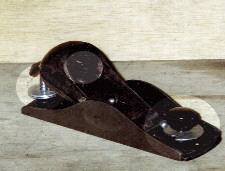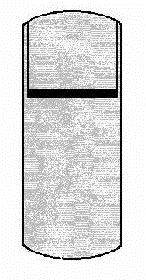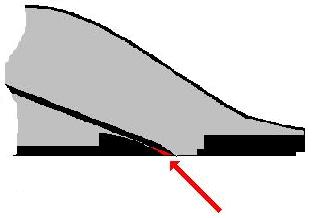Mechanical
Defects
The
first problems
you'll want to address are any mechanical defects. There are
a few
simple ways to "fix" general problems. Missing parts can be
bought
or created. Keep your eye out for a box or can of plane
parts.
I've seen them at flea markets and if you plan to end up with more
than
one or two planes, they may be worth  the
money. Lost toe adjustment knobs can be replace by knobs
found at
hardware stores. The eccentric lever that moves the
toe in
and out can be replaced with a washer that's been filed to shape
-- something
like this. The lever on the quick release cam, located on
the cap
is sometimes broken. You can drill it out and replace the
whole thing
with a hex screw from the same hardware store. I put a hex
nut behind
my cap for additional support. I filed a "V" in one side of
the nut
so it would fit flush against the bottom of the cap, then tapped
the cap
from the bottom side, so the threads would line up. I don't
think
it really adds much more than a little piece of mind, but I like
it. the
money. Lost toe adjustment knobs can be replace by knobs
found at
hardware stores. The eccentric lever that moves the
toe in
and out can be replaced with a washer that's been filed to shape
-- something
like this. The lever on the quick release cam, located on
the cap
is sometimes broken. You can drill it out and replace the
whole thing
with a hex screw from the same hardware store. I put a hex
nut behind
my cap for additional support. I filed a "V" in one side of
the nut
so it would fit flush against the bottom of the cap, then tapped
the cap
from the bottom side, so the threads would line up. I don't
think
it really adds much more than a little piece of mind, but I like
it.
The
Sole
Fixing
the sole
can be simple or complex, depending on the problems. If I
only have
a few scratches on the bottom of the plane I just level the sole
and let
it go at that. Deeper scratches, in critical areas, require
removal
of more surface and can take a lot more time. Here are some
things
that I DON'T recommend.
Using a belt sander. Unless you can find a belt
girt finer
than 120 I'd skip the belt sander. You can end up with
scratches
as deep as the ones you're trying to remove. If you
do use
a belt sander don't keep at it for long periods of time.
The plane
can heat up and you run the risk of deforming the sole while
it's hot,
and having it change shape when it cools.
Files. If you're going to file the sole down, be
very careful.
I've put extra scratches (some of them deep) in the sole
of a plane,
being careless with a file. Once again, you can remove a
lot of metal
very quickly but you can also remove to much. If you're
determined
to use a file, use it across the sole, not along the sole.
That way
any scratches will create less problems.
Orbital sanders. If you have one on which you've
replaced
the rubber pad with a steel or Plexiglas pad you might be
okay. But
the rubber won't flatten the sole. It will just remove
material.
Again, if you do use an orbital sander, don't use grit that's
larger than
120. Go for 220 or finer. You can end up removing a
lot of
material and still have to remove as much by hand!
Ask me how I know all this.
I finally ended up using a sanding disk that fits in my 1/4 in
electric
drill. It'll remove material quickly and I have a lot more
control
over it than the file. There are some rules I've learned
to follow.
-Only tighten the plane in the vice enough to hold it
there.
Excess pressure on the sides will push the center up and
I'll end up with
a concave sole when I take it out of the vice.
-Keep the sander moving at the same speed.
Don't slow down, don't
speed up. If I do I'll introduce low spots or
leave streaks in the
sole.
-Make a number of passes. Only work on a strip
about 1/4 to 1/2
wide at a time. Don't use a lot of pressure or
I'll be creating work
for myself later on.
-By this time it should come as no surprise that I
recommend using medium
grit sanding disks. (120 or finer.)
-I work both from the front and from the back of the
plane. This
will keep me from creating a set of ridges. Most
planes have a convex
sole.
-After I think I'm through with the grinding, I take
the plane out of
the vice and make a few swipes over my flat
surface and look at the
sole. If there are places that are higher than
other places, they'll
have telltale scratches on them. I go back to
the disk sander and
remove extra metal in these areas. I repeat as
necessary. (I
don't want to over do it, or I'll end up having to
remove metal from places
that were originally too low.)
|

| When I get through I should see fine scratches
in the sole. When
I remove these by lapping the sole will be flat. |
|
You may find that using a file or a stone or a belt (or
orbital) sander
works for you. If so, more power to you. The above
is what
works for me.
The
Mouth.
Chips, scratches or a concave toe at the mouth are some of the
hardest
problems to fix. Examine the area. How deep is the
problem?
If it's fairly shallow, grinding, then lapping the sole may
be all
that's needed. If, on the other hand, it's deeper than I
want to
go with a grinder, my only answer is to re-create the
mouth.
When I do this, I want to go slow. I expect to spend a
lot
of time on this area. Correcting both problems with the toe
and the
back of the mouth will result in the mouth being slightly larger
then it
was when I started.

The red arrow points to a problem you
can have if you
don't watch what you're doing.
If you don't hold the file parallel to the work
area., you'll round
the mouth so that it won't support the
blade. The only way
to cure this is to take off MORE metal, making the
mouth longer.
If the toe can't come within a few 1/32 of the blade
you've lost a bit
of the usefulness of the plane.
|
If the problem is in the back of the
mouth, then I have
no choice but to file it down. I use a small fine
cut file.
I can take off a lot of metal in a short amount of time
with a basted file.
I start by disassembling the plane. You can leave
the Iron adjustment
lever if you like, but everything else has to come
off. (You'll have
to punch, or drill the little axle out of the
plane body if you want
to remove the lever. Then you'll have to replace
it when you're done.
Be careful when you're doing this, you're working with
cast Iron and can
damage the frog. I'd follow the Doctor's motto, "first
do no harm.")
I put the file in a bench vice, tilted, back end
down, at about a 20
to 25 degree angle. I make sure I've got
good light.
I work from side to side keeping everything
square. I take my time.
The blade support at the back of the mouth has to line
up with the top
of the adjustment lever. While I'm at it,
I watch that I don't
remove the little fingers off the top of the
adjustment lever. The
end result has to be flat. If it isn't, then
I'll have a blade that
isn't supported at the back of the mount. This
lack of support can
allow the blade to bend in the mouth, causing it to
grab and pull out fibers.
|
The toe is much easier to work on. If enough material wasn't
removed
in flattening, then I remove the toe from the body and carefully
lap the
back side on my flat surface. I keep the back
square. You can
remove about 1/16 of an inch this way. More than that may
result
in a mouth that can't be closed as far as you would
like. I
use this technique for chips, nicks and a toe that's been worn
concave.
The
Toe
If the toe doesn't want to move freely, I remove it from the
plane.
I examine both the sides of the toe and the slot that the toe
rides in.
Look for debris and rust. I clean this area with a
toothbrush and
some WD-40. If this doesn't cure the problem, I use a small
flat
file to carefully file along the inside of the plane.
I Pass
the toe over my lapping surface a few times on each side.
I
want the toe to slide but not be lose.
The overwhelming theme of this entire process is take your
time.
Don't try to hurry the process. Once you've removed
material, you
can't put it back. Too much is too much and may make a bad
situation worse.
Almost all the cleanup and fix up is done by hand. Power
tools can
ruin a project by to quickly removing material. Before you
buy a
used plane with the idea of bringing it up to standards, make sure
you
have the time to spend doing it. |

